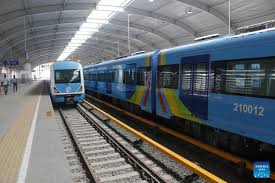by Olatunji Saliu
Feeling the gentle hum of the train beneath him, James Anowai, a content creator and YouTuber, was buzzing with excitement as he settled into his seat on the revitalized Abuja Rail Mass Transit (ARMT) in the Nigerian capital, recently.
For Anowai, whose enthusiasm was palpable, this ride was not only his first-ever train experience or journey from one station to another but also an opportunity to share something new and exciting with his followers about the Abuja light rail built by China Civil Engineering Construction Corporation, a Chinese multinational construction giant.
“Everybody is relaxed. It is very smooth, clean, and, actually, a nice experience. It is something I want to do again, over and over again,” he told Xinhua in an interview, capturing the moment on his camera phone clipped to a tripod.
Since its relaunch for commercial operation about a week ago, talks about the ARMT have been making the rounds, with local media abuzz with the prospect of the light rail system in the fast-developing Nigerian capital city.
With the sleek, air-conditioned new trains and well-secured stations symbolizing a step forward in urban commuting and providing a much-needed reprieve from the city’s traffic congestion, the now invigorated service aims to serve as a beacon of hope amid the economic challenges faced by many in Nigeria’s capital.
During the recent flag-off for commercial operation on May 29, President Bola Tinubu announced that rides on the new metro system would be free until the end of the year — a move expected to encourage residents to embrace this new mode of transport and ease their economic burdens.
Tinubu, who took a ride on the train together with other top officials, described the operations on the Abuja metro line as “a symbolic milestone of enduring progress as a country and in the Federal Capital Territory (FCT),” noting it came about as “a fruit of collaboration, dedication, progress, and foresightedness.”
“The Abuja Metro was inherited by my administration, from my predecessor. It was first commissioned in 2018 for public use,” he said, adding his administration prioritized its revitalization as part of a desire to have a functional and flourishing FCT with efficient public infrastructure and transportation systems that will serve the people who live and work within the city and the surrounding communities.
The completed 45-km Lot A1 and Lot 3 of the light rail, with a total length of 290 km offering intra-city shuttle service and connecting Abuja’s satellite towns to metropolitan transport, are part of the Abuja rail mass transit project designed to have an interface with the national line at two points, where there would be interchanges to join the rail line linking the northern part of Nigeria.
It covers 12 stations, 21 operational offices, 13 bridges, 50 culverts, and nine pedestrian overpasses. The construction of the light rail and its use is expected to open up new towns and boost economic activities along the corridor of Gwagwa, Kalgoni, Dei-Dei, Kubwa, Kukwaba, Dasonga, Asa, among 12 satellite towns in the Nigerian capital of Abuja.
For many passengers, the free ride period has been a much-appreciated relief. Miriam Akpan, a civil servant, expressed her satisfaction with the light rail service, saying: “It is a fantastic initiative.”
“The train is comfortable, and the stations are well-maintained. Now, I can save a lot on transport costs going from my house to the office, and with the satisfaction that this is faster than being stuck in traffic at resumption and closing time,” she said.
Naomi Oboi, a communications specialist, said she had “a very impressive” experience while using the train from the iconic Abuja Metro Station to the Airport Station, which covers a distance of 28 km, to complete an official assignment. Having used the light rail in Lagos, the country’s economic hub, and metro trains in other parts of the world, she said her experience, from the zero-delay boarding to “every single thing” she saw during the travel time on ARMT was without much difference from her previous experiences.
“This is something that, especially with the increase in fuel prices in recent times, would really go a long way to help the average Nigerian, just like me, to make the transportation system very easy and better for us,” Oboi said. “This is quality. This is very good, solid. I would say that I did not expect the train in Nigeria to be this solid, to be honest.”
“Abuja could benefit from expansion plans,” Mustapha Bello, a student at the University of Abuja, told Xinhua, noting that “as the city’s residents adapt to this new system, the hope is that it will not only alleviate daily commuting woes but also contribute to the overall economic and social well-being of the Nigerian capital.”
Reflecting on his “very unforgettable journey,” Anowai expressed his hopes for the future of the rail service, wishing to have the light rail fully extended to Kuje, a low-income suburb of Abuja, where he lives, and works in the city center.
“It is just a smooth ride. I do not need to use public transport or drive my vehicle to this location. It has been a nice journey. This is more than an easy life,” he added while adjusting his camera phone and tripod for his next content piece around the metro. Enditem
XINHUA

